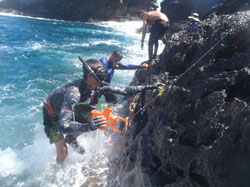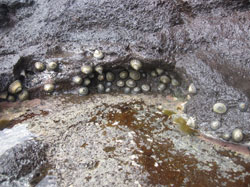
Intertidal Monitoring Cruise returns from Papahānaumokuākea

Intertidal monitoring team members monitoring the rocky intertidal shoreline in between waves at Mokumanamana. Credit: Dean Tokishi
On Monday, September 24, 2012, the intertidal monitoring expedition to Papahānaumokuākea Marine National Monument returned from the fourth consecutive year of conducting research in the rocky intertidal zones of the Northwestern Hawaiian Islands.
This year, the team focused on learning more about ʻopihi (limpet) spawning activity.
"The importance of this work is to gain new information on this iconic food species to better manage fisheries across the archipelago," says Hoku Johnson, NOAA's coordinator of the expedition. "The research in the Monument is connected to similar research begin done in partnership in the main Hawaiian islands, which we hope will lead to better management of ʻopihi state-wide."
These shorelines were historically important; while the men fished out at sea, Native Hawaiian women negotiated the intertidal zone (the area that is above water at low tide and under water at high tide) to gather ʻopihi and haʻukeʻuke (helmet urchin). The flesh of these species was used for food and their shells used as tools for scraping kalo (taro) and niu (coconut) and imprinting kapa cloth.
Compared to the main Hawaiian Islands, the rocky shorelines within the Monument are pristine and host many species of invertebrates, fish, and seaweeds. However, data on species abundance and presence/absence within the intertidal zone in the Northwestern Hawaiian Islands has only recently been systematically collected.
The team spent 12 days carrying out various activities, including conducting transects from the highest to lowest tide marks, researching ʻopihi spawning behavior, collecting algae and invertebrates for DNA analysis, and documenting observations of weather and animal interactions to gain further information on atmospheric and seasonal cycles from a Native Hawaiian perspective.

ʻOpihi line the rocky shorelines of Papahānaumokuākea, Northwestern Hawaiian Islands. Credit: Hoku Johnson
"Through recording everything daily about the weather, our surroundings, animal interactions and weather movements across the atolls and islands, we were able to connect further with our kūpuna and gain insight into the importance of being humble and totally aware of our surroundings," says Shauna Kehaunani Springer, a cultural researcher from Hawaiʻi Island.
In reverence to the Native Hawaiian connection, researchers offered chants and small gifts of water and salt prior to conducting their research activities.
The team's research on ʻopihi shed new light on their reproduction.
"We have preliminary evidence that female ʻopihi live higher on the rocky shore than male ʻopihi," says Dr. Chris Bird, a scientist from Texas A&M University, noting an interesting highlight from the research. "This is a groundbreaking discovery that will contribute toward better understanding of 'opihi reproduction, which will help marine managers when considering restoration of ʻopihi habitat in populated areas like Oʻahu."
The researchers also explored the hypothesis that ʻopihi in the Northwestern Hawaiian Islands are bigger when they reach reproductive readiness than those in the Main Hawaiian Islands, indicating that increased pressure from fisheries forces them to reproduce at an earlier – and thus smaller – life stage.
The monitoring team consisted of participants from NOAA, Texas A&M University, the Scripps Institute of Oceanography, The Nature Conservancy, Nā Maka o Papahānaumokuākea, Conservation International-Hawaii Fish Trust, Kahoʻolawe Island Reserve Commission, Kalapana Fishing Council, Nā Mamo o Muoleʻa and Kipahulu ʻOhana.
For pictures from the expedition, click here.
For videos from the expedition, click here.
To see the Press Release, click here.